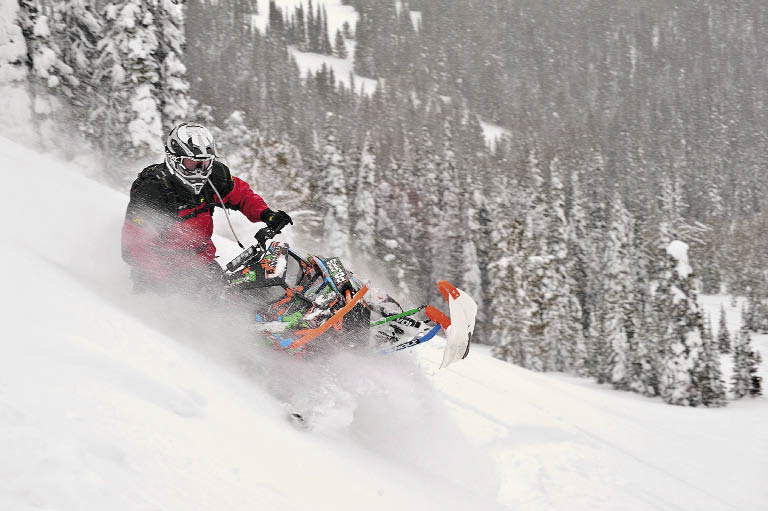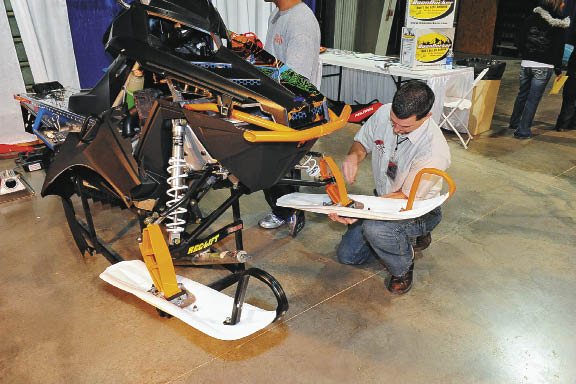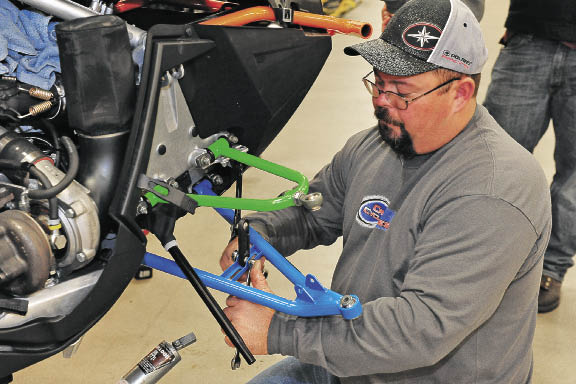 Flashy colors, hot rod power and a lot of bling ... sounds about right for a mid-life crisis. But there's more to Project MLC than that.
Flashy colors, hot rod power and a lot of bling ... sounds about right for a mid-life crisis. But there's more to Project MLC than that.
When Polaris introduced its 2011 Pro RMK, we thought the peak of mountain snowmobile performance had been reached.
But you can always count on the aftermarket to improve anything.
First-Year Hardware
Dealing with a first-year model is also tricky when you're building a custom machine. Aftermarket companies can't build parts until they have a machine that they can tear apart and that usually means late fall. That was the case as we set out to build Project MLC. In fact, our Polaris Pro RMK 155 was the sled that Boondocker used to develop its first Pro turbo kit. Pretty impressive when you consider too that Boondocker techs Jared Sessions and Tony Jenkins installed the kit for the first time during the Intermountain Snowmobile Show and did it in two hours. And if you think that it was a quick install that skipped a few steps, Project MLC left the show and went straight to Wyoming for an early season ride.
But before we made it that far, we had to get physical. That means the day after we picked up our 2011 Pro RMK from Rexburg Motor Sports, we started tearing it apart. Many people have commented about the irony of how some service tech at the dealership busted his butt to get the sled assembled and set up just in time for us to pick it up and undo everything he did.
Tear-Down
First, we replaced the red side panels with black ones from Polaris and we left the foam lining off of the black panels to shed a few ounces. We removed the hood and pulled the foam off it as well. All that foam added up to a 2-lb. savings.
Next, we removed the headlight and put it in a box-another 3.25 lbs saved. We peeled the stock graphics off of any remaining places and removed the running board edge rails, bumpers, hood vents, handlebar clamp and spindles so they could be powdercoated in various Starburst colors. Once we got the colored parts back from Ace Powder Coating in Idaho Falls, ID, we reassembled the sled to "stock" condition and loaded it into the trailer for the Intermountain Snowmobile Show.
Intermountain Snowmobile Show Build
At the show in Salt Lake City, UT, Jeff Hawksworth from Skinz Protective Gear installed SPG front and rear bumpers and Airframe seat. The front bumper provides a very sturdy protection element and strong grab point for pulling on a stuck sled. The SPG rear bumper adds some weight compared to the stock carbon fiber tube bumper, but durability is critical in a rear bumper-especially the way we ride these sleds in the trees. The Airframe seat gives us a very mountain-riding-friendly feel with a very trick look and added storage with the SPG bag.
As mentioned, the Boondocker crew installed the pump gas turbo kit (including clutch components, Control Box and Electronic Boost Controller or EBC). One thing that was new for 2011 is how Boondocker pre-assembles the turbo kits at the factory so your installation job is simplified. That was one of the reasons we wanted to see if the turbo kit could be installed in a two-hour time frame. Typically, turbo kits could take anywhere from eight hours to a couple of days to install. But having them pre-assembled with clear instructions and capable technical support readily available by phone has cut a lot of labor time out of the process.
Other keys to Boondocker's turbo kits being so successful are the timing key, exclusive TPS-Smart Electronic Boost Controller, Control Box with 3D tuning, a deep-snow tunnel exhaust outlet design, new Torque Building Air Box, No-Spill oil tank, intercoolers and cold air intakes.
Boondocker's 3D tuning builds a three-dimensional fuel map based on boost, engine rpm and throttle position (rather than a two-dimensional map based on just two data inputs). The 3D tuning and timing key is what makes the turbo run clean and crisp like a stock engine prior to boost and seamlessly roll into boost power without a hiccup, lean spot or detonation.
At the Intermountain Snowmobile Show, we also had one side of our ArcticFX custom-colored "Broken Arrow" wrap installed by Dan Adams, an ArcticFX-sponsored Pro rider who has installed more than his fair share of wrap kits over the years.
Starting Line Products' Dustin Pancheri installed a set of white Powder Pro skis on Project MLC. Initially, we weren't sure if we'd stick with the Powder Pros once we hit the snow. It all depended on how the new chassis handled. But we can tell you that we never pulled them off. They are absolutely outstanding for the Pro RMK chassis. Pancheri also helped install a set of Stomp Grip pads to the tunnel sides, which are an adhesive-backed pad that has knobs on it that you can use to grip the sled with the inside of your boots. SLP carries Stomp Grips and Stomp Grip seat covers.
 Idaho Snowmobile Show Build
Idaho Snowmobile Show Build
A few weeks later, and with three more good October/November mountain rides on Project MLC, we loaded up and went to the Idaho Snowmobile Show in Boise, ID, for another round of installs.
Wade Durbin, Lance Robinson and Larry Chess of RSI Racing installed a set of 5-inch rise handlebars and gel-wrap grips with RSI grip heaters. We cut about half an inch off each end of the bars to narrow up the controls a bit. The gel-wrap grips provide great grip and comfort while absorbing vibrations.
Holz Racing Products provided a set of lightweight A-arms for Project MLC and Carl's Cycle service technicians Bill and Kevin came over to the show to install them for us. The upper A-arm on the Polaris uses a threaded ball joint to adjust the spindle's camber. Carl's Cycle recommends having any installation or adjustment done by someone who knows how to properly set up the camber angle or the sled's handling will go out the window.
Fox Racing Shox sent a set of Float EVOL air shocks for the front end of Project MLC and the Carl's Cycle techs installed those along with the Holz arms. The Fox Float EVOLs are the best of both worlds of air shocks: they are lightweight and benefit from the external "Extra VOLume" chamber to maintain the shock's performance under grueling conditions. We also installed a set of Fox Shox on the stock rear suspension initially to test and ride quality was superb. We found a comfortable setting with 65 psi in the main chamber of the ski shocks and 160 psi in the EVOL chamber. We ran 110 psi in the main chamber of the rear track shock with 200 psi in its EVOL chamber. That gave us a plush ride at speed down a rough, shelled out trail and performed very well off-trail in deep fluff and steep climbs.
Project MLC needed the ArcticFX graphics installed on the other side at Boise and Dan Adams' wife, Irina, took care of that task.
Once again, Project MLC left the show in a trailer headed for big mountains and deep snow. This time, Boondocker took it to Colorado for some November riding and more testing.




More Installs
As the season progressed, we added more parts. We took the sled over to Jackson, WY, where we installed an Enhancement Kit from Most Wanted Performance. The Enhancement Kit serves as a bypass valve that keeps cooled-off coolant in the tunnel heat exchangers from circulating through a still-hot engine after the sled has sat for a few minutes. The Enhancement Kit circulates the coolant that is in the front or engine portion of the cooling system and slowly bleeds in cold coolant from the tunnel as the engine temp steadies out. The Enhancement Kit comes into play when the sled is first started in the morning, too, shortening the cooling circuit the same way, which allows the engine to reach operating temperature more quickly. That is key to preventing piston scuffing and engine damage or failure. We were very pleased with how the sled's cooling system operated with the Gizmo installed.
Another late addition to Project MLC was a full Mtn. Tamer rear suspension from Timbersled Products, complete with black IceAge slide rails and Fox Float shocks.
Timbersled's Allen Mangum travelled to our backyard to install the skid in Project MLC and stuck around for a couple of days to ride the sled and make any ride quality adjustments. The Mtn. Tamer rear suspension is light (lighter than the stock rail by a couple of pounds) and gives the rider a wide range of adjustment in ride quality and weight transfer control. The Mtn. Tamer features a sealed, greasable slide mechanism on the rear arm with a knob for coupling control with infinite adjustment capability. The Mtn. Tamer is a tried and proven piece of dedicated mountain hardware.
After a few months of riding, we had a sag in the running boards. We installed a set of Better Boards running board inserts and Lincoln County Customs helped us install a set of custom-made tunnel reinforcements.
 Project MLC Wrap-Up
Project MLC Wrap-Up
So did all of these modifications and bolt-on products leave us with a better sled than we started with?
Yes. Our riding preferences lead us into trees, ugly canyons and long sidehills. The added power from the Boondocker turbo means you can go more places, go deeper into the canyon, go farther on the sidehill and get out of trouble spots like you could not do on a stocker.
The improvements to the chassis, controls and seat made Project MLC very user-friendly for aggressive backcountry riding. Nothing is in the way, the bars are just the right height and the sled is easy to manipulate in sticky situations.
And the suspension upgrades made it a machine that you could hammer through the war zone leading up the mountain and still be completely functional once you're off making your own tracks. We could control weight transfer, nose weight, coupling, rebound and compression damping and could make any changes we needed to the sled's overall ride quality.
From power to handling and everything in between, Project MLC is the prefect combination of components and a core platform for the mountain rider who's going through a mid-life crisis of his own.